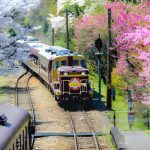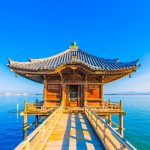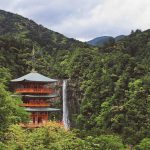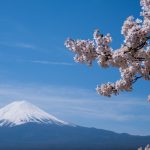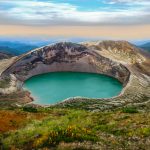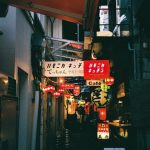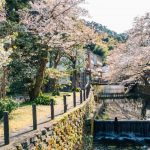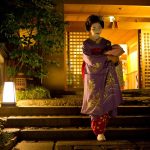Yamabushi (literally one who prostrates himself on the mountain) are mountain monks whose life philosophy is based on their close relationship with nature. They can be found in the mountains of Dewa Sanzan, in Yamagata prefecture.
Let’s find out more about these mysterious mountain hermits!
History of Yamabushi and Shugendo

Shintoism had been the main religion in Japan until the 6th century when Buddhism was introduced in the country from the Korean peninsula. At that time, religion was a useful tool to maintain a strong central power and the advent of Buddhism had the potential to challenge that balance of power. The emperor of Japan was Shintoist and believed to be a direct descendant of the Shinto goddess Amaterasu.
Buddhism was finally allowed and the two spiritualities lived in harmony in Japan. In the 8th century, Shugendo was born from a fusion between Shinto and esoteric Buddhism. The main pillar of this life philosophy is the strong relationship between man and nature.
Shugendo practitioners are called Yamabushi. At the beginning, they practiced their religion in solitude but then they started to gather around mountainous areas, the most famous of which is Dewa Sanzan in Yamagata.
Dewa Sanzan – The 3 Sacred Mountains of Dewa

Dewa Sanzan means “the 3 mountains of Dewa”. It is a sacred place composed of 3 mountains:
- Mount Haguro or Haguro-san,
- Mount Gassan,
- Mount Yudono or Yudono-san.
It was Prince Hachiko, the son of Emperor Sushun, who first made the Dewa Sanzan mountains a religious site back in 593.
Over the years, these mountains have become a popular pilgrimage site and the famous monk Kobo Daishi (also known as Kukai), the founder of Shingon Buddhism, visited them.
The pilgrimage begins on Mount Haguro which represents the present or birth. Then comes the ascent of Mount Gassan which represents the past or death. It ends at Mount Yudono which represents the future or rebirth.
The whole trip to Dewa Sanzan is believed to be a journey to rebirth, at the end of which an entirely new life would be waiting for you.

Yamabushi wear white in reference to the white sheets with which the bodies of the dead are covered. This may sound a bit gloomy to you but according to Buddhist beliefs, death is only the end of a life cycle and the Dewa Sanzan pilgrimage would only allow you to start a new one.
Buddhism and Shintoism have long coexisted in perfect harmony in Japan but during the Meiji period (1868-1912), the Japanese government decided to separate the two religions. Many Buddhist temples were forcibly transformed into Shinto shrines and Dewa Sanzan was no exception.
Yamabushi tried to resist this forced conversion but finally accepted it because Shugendo, the basis of their faith and spiritual practice, was not questioned.

To experience the life of a yamabushi at Dewa Sanzan, let’s take part in the pilgrimage and climb to the top of Mount Haguro. We will do that after spending the night in a temple at the foot of this same mountain.
Stay At Shukubo Daishinbo

Before climbing up the three sacred mountains, pilgrims usually spend the night in a temple to rest and prepare for the pilgrimage. Those are called shukubo and are usually run by yamabushi.
Before climbing up Haguro-san, we spent the night in a shukubo called Daishinbo and run by a yamabushi named Kazuhiro Hayasaka. The Daishinbo is a family business founded in the 17th century and Kazuhiro is a member of the 17th generation!

This shukubo is located 5 minutes from the beginning of the hiking trail to Haguro-san so it’s the perfect place to rest before and after the climb. And if you happen to have any questions about yamabushi, the owner will be more than happy to answer them.

As far as meals are concerned, we were served Shojin Riyori, an assortment of traditional Buddhist dishes that is usually vegetarian; although following the conversion to Shintoism in the Meiji era, this Buddhist tradition was abandoned and some Shojin Riyori now contain fish.

During training, yamabushi can only eat food from the mountain. At the end of their training, they are allowed to eat fish, thus breaking their spiritual fast, or what they call their shojin otoshi.
Another characteristic of Dewa Sanzan’s cuisine is that it includes many wild mountain vegetables, which is very important in this mountainous region considering that it is not very suitable for agriculture. Moreover, these mountain vegetables are considered blessings from nature, a belief that blends perfectly with the essence of Shugendo.
Before we get going, the temple’s yamabushi organized a morning ceremony to bring us luck during our pilgrimage. Here’s what it looked like:
Pilgrimage To The Top Of Mt Haguro
We left the shukubo in the morning and headed towards Haguro-san. During winter, the weather can be pretty cold so make sure to choose your clothes accordingly.

If you are interested, you can rent the traditional yamabushi costume from the shukubo and wear it during the pilgrimage. It costs 5,000 yen per day.

You will also be provided with tabi which is comfortable and suitable for mountain hiking.

The start of the pilgrimage is marked by an impressive torii which symbolizes the entrance to a sacred place in Shintoism. During the Meiji period, the kanji of Buddhism which were engraved on the torii were erased.

The forest we crossed is otherworldly: no wonder this place has inspired and fascinated people for centuries.

We came across waterfalls and the yamabushi told us that some monks purify themselves with their sacred water by diving into the river downhill.

We were given some instructions by the yamabushi during the pilgrimage and we had to answer by shouting “uketamo” meaning “I accept”.

We also came across a beautiful 600+ year old cedar tree! There was also a majestic 5-storey pagoda, built in 1372, back when the site was Buddhist. It looks like a simple tree lost in the forest and has been classified as a national treasure since 1966.
We reached the top of Mount Haguro after about one hour of hiking.

There is a Shinto shrine up there called Ideha (Dewa Sanzan) and you can also have a lunch of Shojin Ryori at Saikan Temple.

Ideha Cultural Museum

To learn more about yamabushi and Dewa Sanzan, please visit the Ideha Cultural Museum located right next to the entrance of Dewa Sanzan. The entrance is free but the admission for the Exhibition Room is 400 yen and you can rent a pilgrim stick over there for 100 yen.
I must admit I felt oddly reborn after climbing Mount Haguro. Being lost in such beautiful nature is fascinating yet grounding, and feeling a sense of belonging to an anwe-inspiring ecosystem that is beyond our grasp makes us look at life with simpler and humbler eyes.
Thank you for reading!
MF



